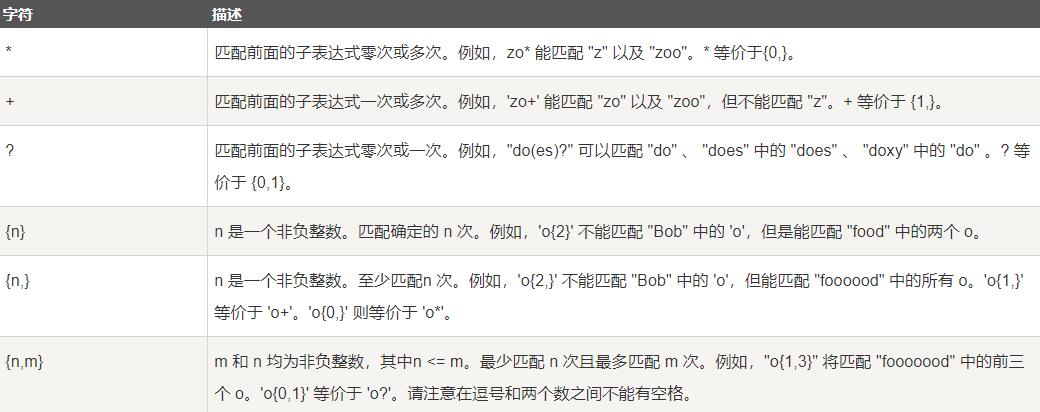码丁实验室,一站式儿童编程学习产品,寻地方代理合作共赢,微信联系:leon121393608。
通过一个小实例来了解正则表达式的作用
# 从字符串 str 中找出abc/数字
import re
s = '123abc456eabc789'
re.findall(r'abc', s)
# result: ['abc', 'abc']
re.findall('[0-9]+',s)
# result: ['123', '456', '789']
限定符
限定符用来指定正则表达式的一个给定组件必须要出现多少次才能满足匹配。有 * 或 + 或 ? 或 {n} 或 {n,} 或 {n,m} 共6种。

import re
s = 'Chapter1 Chapter2 Chapter10 Chapter99 fheh'
re.findall('Chapter[1-9][0-9]*', s)
# result:['Chapter1', 'Chapter2', 'Chapter10', 'Chapter99']
re.findall('Chapter[1-9][0-9]+', s)
# result: ['Chapter10', 'Chapter99']
re.findall('Chapter[1-9][0-9]?', s)
# result:['Chapter1', 'Chapter2', 'Chapter10', 'Chapter99']
re.findall('Chapter[1-9][0-9]{0,1}', s)
# result:['Chapter1', 'Chapter2', 'Chapter10', 'Chapter99']
re.findall('Chapter[1-9][0-9]{1,2}', s)
# result:['Chapter10', 'Chapter99']
贪婪匹配与非贪婪匹配
正则匹配默认是贪婪匹配,也就是匹配尽可能多的字符
import re
# 贪婪模式
s = '<H1>Chapter 1 – Introduction to Regular Expressions</H1>'
re.findall('<.*>', s)
# result: ['<H1>Chapter 1 – Introduction to Regular Expressions</H1>']
# 非贪婪模式
re.findall('<.*?>', s)
# result: ['<H1>', '</H1>']
定位符
定位符使您能够将正则表达式固定到行首或行尾。它们还使您能够创建这样的正则表达式,这些正则表达式出现在一个单词内、在一个单词的开头或者一个单词的结尾。
定位符用来描述字符串或单词的边界,^ 和 $ 分别指字符串的开始与结束,b 描述单词的前或后边界,B 表示非单词边界。

import re
s = 'Chapter1 Chapter2 Chapter11 Chapter99'
re.findall('^Chapter[1-9][0-9]{0,1}', s)
# result: ['Chapter1']
re.findall('^Chapter[1-9][0-9]{0,1}$', 'Chapter99')
# result: ['Chapter99']
re.findall(r'bCha', ' Chapter')
# result: ['Cha']
re.findall(r'terb', ' Chapter')
# result: ['ter']
re.findall(r'Bapt', 'Chapter')
# result: ['apt']
re.findall(r'Bapt', 'aptitude')
# result: []
分组与捕获组
要说明白捕获,就要先从分组开始。重复单字符我们可以使用限定符,如果重复字符串,用什么呢? 对!用小括号,小括号里包裹指定字表达式(子串),这就是分组。之后就可以限定这个子表示的重复次数了。
那么,什么是捕获呢?使用小括号指定一个子表达式后,匹配这个子表达式的文本(即匹配的内容)可以在表达式或者其他过程中接着用,怎么用呢?至少应该有个指针啥的引用它吧? 对!默认情况下,每个分组(小括号)会自动拥有一个组号,从左到右,以分组的左括号为标志,第一个出现的分组组号为1,后续递增。如果出现嵌套,
s = 'aaa111aaa , bbb222 , 333ccc'
re.findall(r'[a-z]+(d+)[a-z]', s)
# result:['111']
re.findall(r'[a-z]+d+[a-z]', s) # 对比(d+)的用法
# result:['aaa111a']
re.findall(r'[a-z]+d+[a-z]+', s) # 对比(d+)的用法
# result:['aaa111aaa']
s = '111aaa222aaa111 , 333bbb444bb33'
re.findall(r'(d+)([a-z]+)(d+)(2)(1)', s)
# result:[('111', 'aaa', '222', 'aaa', '111')]
re.findall(r'(d+)([a-z]+)(d+)(2)(1)', '333bbb444bb33')
# result:[]
re.findall(r'(d+)([a-z]+)(d+)(2)(1)', '333bbb444bbb333')
# result:[('333', 'bbb', '444', 'bbb', '333')]
re.findall(r'(d+)([a-z]+)(d+)(1)(2)', '333bbb444bbb333')
# result:[]
非捕获组
用圆括号将所有选择项括起来,相邻的选择项之间用|分隔。但用圆括号会有一个副作用,使相关的匹配会被缓存。可用?:放在第一个选项前来消除这种副作用。
其中 ?: 是非捕获元之一,还有两个非捕获元是 ?= 和 ?!,这两个还有更多的含义,前者为正向预查,在任何开始匹配圆括号内的正则表达式模式的位置来匹配搜索字符串,后者为负向预查,在任何开始不匹配该正则表达式模式的位置来匹配搜索字符串。
# (?:pattern)与(pattern)不同之处只是在于不捕获结果,非捕获组只匹配结果,但不捕获结果,也不会分配组号
s = 'industry is industries lala industyyy industiii'
re.findall(r'industr(?:y|ies)', s)
# result: ['industry', 'industries']
s = 'Windows2000 Windows3.1'
re.findall(r'Windows(?=95|98|NT|2000)', s)
# result: ['Windows']
# 匹配 "Windows2000" 中的 "Windows",不匹配 "Windows3.1" 中的 "Windows"。
s = 'Windows2000 Windows3.1'
re.findall(r'Windows(?!95|98|NT|2000)', s)
# result: ['Windows']
# 匹配 "Windows3.1" 中的 "Windows",不匹配 "Windows2000" 中的 "Windows"。
s = 'aaa111aaa,bbb222,333ccc,444ddd444,555eee666,fff777ggg'
re.findall(r'([a-z]+)d+([a-z]+)', s)
# result:[('aaa', 'aaa'), ('fff', 'ggg')]
re.findall(r'(?P<g1>[a-z]+)d+(?P=g1)', s)
# result:['aaa']
re.findall(r'(?P<g1>[a-z]+)d+(?P=g1)', 'aaa111aaa,bbb222,333ccc,444ddd444,555eee666,fff777fff')
# result:['aaa', 'fff']
re.findall(r'[a-z]+(d+)([a-z]+)', s)
# result: [('111', 'aaa'), ('777', 'ggg')]
re.findall(r'([a-z]+)d+', s)
# result:['aaa', 'bbb', 'ddd', 'eee', 'fff']
re.findall(r'([a-z]+)d+1', s)
# result:['aaa']
s = 'I have a dog , I have a cat'
re.findall(r'I have a (?:dog|cat)', s)
# result: ['I have a dog', 'I have a cat']
re.findall(r'I have a dog|cat', s)
# result: ['I have a dog', 'cat']
s = 'ababab abbabb aabaab abbbbbab'
re.findall(r'b(?:ab)+b', s)
# result: ['ababab']
re.findall(r'b(ab)+b', s)
# result: ['ab']
反向引用
捕获组(Expression)在匹配成功时,会将子表达式匹配到的内容,保存到内存中一个以数字编号的组里,可以简单的认为是对一个局部变量进行了赋值,这时就可以通过反向引用方式,引用这个局部变量的值。一个捕获组(Expression)在匹配成功之前,它的内容可以是不确定的,一旦匹配成功,它的内容就确定了,反向引用的内容也就是确定的了。
反向引用必然要与捕获组一同使用的,如果没有捕获组,而使用了反向引用的语法,不同语言的处理方式不一致,有的语言会抛异常,有的语言会当作普通的转义处理。
s = 'Is is the cost of of gasoline going up up ?'
re.findall(r'b([a-z]+) 1b', s, re.I) # 大小写不敏感
# result: ['Is', 'of', 'up']
re.findall(r'b([a-z]+) 1b', s)
# result: ['of', 'up']
s = 'http://www.w3cschool.cc:80/html/html-tutorial.html'
re.findall(r'(w+)://([^/:]+)(:d*)?([^# ]*)', s)
# result: [('http', 'www.w3cschool.cc', ':80', '/html/html-tutorial.html')]
注意区别:pattern+?、pattern*?、(?!pattern)、(?:pattern)
pattern+?、pattern*?
这两个比较常用,表示懒惰匹配,即匹配符合条件的尽量短的字符串。默认情况下 + 和 * 是贪婪匹配,即匹配尽可能长的字符串,在它们后面加上 ? 表示想要进行懒惰匹配。
(?!pattern)
表示一个过滤条件,若字符串符合 pattern 则将其过滤掉。在分析日志时很有用,例如想过滤掉包含 info 标记的日志可以写 ^(?!.info).$。
(?:pattern)
这条规则主要是为了优化性能,对匹配没有影响。它表示括号内的子表达式匹配的结果不需要返回也不会被  2 之类的反向引用。
2 之类的反向引用。
模式匹配
- import re导入正则表达式模块。Python中所有正则表达式的函数都在re模块中,所以我们要先引入re模块;
- 用re.compile()函数创建一个Regex对象(参数就是要匹配的内容的正则表达式);
- 用Regex对象的search()方法来查找一段字符串,返回那个匹配的对象num,num中是一段相应的描述信息;
- 调用匹配对象num的group()方法,返回实际匹配文本的字符串。
import re
s1 = "once upon a time"
s2 = "There once was a man from NewYork"
print(re.findall(r'^once', s1))
# result: ['once']
print(re.findall(r'^once', s2))
# result: []
print(re.findall(r'time$', s1))
# result: ['time']
print(re.findall(r'times$', s1))
# result: []
print(re.findall(r'^time$', s1))
# result: []
print(re.findall(r'^time$', 'time'))
# result: ['time']
## compile
s = '111,222,aaa,bbb,ccc333,444ddd'
rule = r'bd+b'
compiled_rule = re.compile(rule)
print(compiled_rule.findall(s))
# result: ['111', '222']
## match
print(re.match('www', 'www.runoob.com').span()) # 在起始位置匹配
# result: (0, 3)
print(re.match('com', 'www.runoob.com')) # 不在起始位置匹配
# result: None
line = "Cats are smarter than dogs"
matchObj = re.match(r'(.*) are (.*?) .*', line, re.M | re.I)
if matchObj:
print("matchObj.group() : ", matchObj.group())
# result: matchObj.group() : Cats are smarter than dogs
print("matchObj.group(1) : ", matchObj.group(1))
# result: matchObj.group(1) : Cats
print("matchObj.group(2) : ", matchObj.group(2))
# result: matchObj.group(2) : smarter
else:
print("No match!!")
## search
print(re.search('www', 'www.runoob.com').span()) # 在起始位置匹配
# result: (0, 3)
print(re.search('com', 'www.runoob.com').span()) # 不在起始位置匹配
# result: (11, 14)
line = "Cats are smarter than dogs";
searchObj = re.search(r'(.*) are (.*?) .*', line, re.M | re.I)
if searchObj:
print("searchObj.group() : ", searchObj.group())
# result: searchObj.group() : Cats are smarter than dogs
print("searchObj.group(1) : ", searchObj.group(1))
# result: searchObj.group(1) : Cats
print("searchObj.group(2) : ", searchObj.group(2))
# result: searchObj.group(2) : smarter
else:
print("Nothing found!!")
## match与search
line = "Cats are smarter than dogs"
matchObj = re.match(r'dogs', line, re.M | re.I)
if matchObj:
print("match --> matchObj.group() : ", matchObj.group())
else:
print("No match!!")
# result: No match!!
matchObj = re.search(r'dogs', line, re.M | re.I)
if matchObj:
print("search --> matchObj.group() : ", matchObj.group())
# result: search --> matchObj.group() : dogs
else:
print("No match!!")
## sub
phone = "2004-959-559 # This is Phone Number"
num = re.sub(r'#.*$', "", phone)
print("Phone Num : ", num)
# result: Phone Num : 2004-959-559
num = re.sub(r'D', "", phone)
print("Phone Num : ", num)
# result: Phone Num : 2004959559
正则表达式与BeautifulSoup
from urllib.request import urlopen
from bs4 import BeautifulSoup
import re
html = urlopen("http://www.Pythonscraping.com/pages/page3.html")
bsObj = BeautifulSoup(html, 'lxml')
# print(bsObj.prettify())
images = bsObj.findAll("img", {"src": re.compile("../img/gifts/img.*.jpg")})
for image in images:
print(image["src"])
# result: ../img/gifts/img1.jpg
# ../img/gifts/img2.jpg
# ../img/gifts/img3.jpg
# ../img/gifts/img4.jpg
# ../img/gifts/img6.jpg

